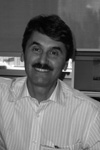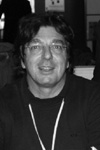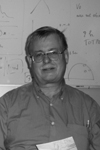principles of fluorescence techniques
june 29-july 2, 2009 | genova, italy
Dr. Beniamino Barbieri | ISS, Inc. | President | 1602 Newton Dr. | Champaign, IL 61822 | USA | Tel: 217-359-8681 | beniamino.barbieri@iss.com
Dr. Paolo Bianchini | University of Genova | Department of Physics | LAMBS-IFOM MicroSCoBIO Research Center | 16146 Genova | Italy | Tel: +39-0103536309 | bianchini@ge.infm.it
Paolo Bianchini is a PhD student at the University of Genoa in the Applied Physics Department. His research activity involves the study of biological molecules to address cell functioning using conventional, confocal and multiphoton fluorescence microscopy, SHG, FLIM, single molecule imaging, scanning probe microscopy, spectral microscopy, nanostructured model systems, and bioimaging. He ie a member of IFOM (Institute for Cancer Research, Milan) and MicroScoBio (Research Center for Correlative Microscopy in Biomedicine and Oncology).
Prof. Ranieri Bizzarri | Scuola Normale Superiore | National Enterprise for Nanoscience and Nanotechnology | Piazza dei Cavalieri, 6 | 56100 Pisa | Italy | Tel: +39-050-509-434 | r.bizzarri@sns.it
In 1997 Dr. Ranieri Bizzarri got a M.Sc. in Chemistry with honors as student of Scuola Normale Superiore (SNS) in Pisa. Dr. Bizzarri got his PhD with honors in 2001 with a thesis, "New Polymeric Materials for Tissue Engineering Applications," under the supervision of Prof. Emo Chiellini. As a PhD student, he was a visiting fellow at the University of Paris XII/CNRS and at Cornell University (NY, USA). Then he worked as researcher at Kedrion Biopharmaceuticals and as post-doc at the University of Pisa on a project concerning the production of new nanomaterials for drug delivery applications. In 2003 Dr. Bizzarri won a position as research assistant at SNS until may 2010; he works in NEST laboratory of SNS directed by Prof. Fabio Beltram.
Dr. Bizzarri is co-author of 29 journal articles, two book chapters, and one patent. He is a lecturer at two annual courses at SNS. He has been a speaker at more than 15 international conferences, co-organized a session at the 2008 meeting of the Biophysical Society, and is currently organizing an international meeting entitled "Autofluorescent proteins: the colorful revolution of molecular biology" to be held in Genova, Italy on July 10th.
His early scientific interests encompassed the preparation and engineering of biodegradable polymeric materials for biomedical applications such as protein drug delivery and soft tissue reconstruction. At Cornell University, Dr. Bizzarri became interested in the use of fluorescent probes to visualize intracellular processes. In 2003 he started an intense research activity on nanobiotechnology applied to biomedicine at SNS. He focused mainly on the engineering of new fluorescent probes for in vivo biochemical detection with high spatial-temporal resolution. In his career, he has acquired skills in organic/polymer chemistry, molecular spectroscopy, and confocal microscopy. He has a strong nanobiotechnology background focused on the photophysical properties of matter, self-assembly processes, and nanomedicine.
Prof. Alberto Diaspro | University of Genova | Department of Physics | Nanoscopy and NIC@IIT | 16146 Genova | Italy | Tel: +39-0103536426 | diaspro@fisica.unige.it
Alberto Diaspro is Director of the Department of Nanophysics at the Istituto Italiano di Tecnologia (IIT), Deputy Director of IIT, Chair of the Nikon Imaging Center at IIT (www.nic.iit.it). Diaspro is Professor of Applied Physics at the Department of Physics of University of Genova and supervisor for the Ph.D. Courses in the Bioengineering and Robotics and Physics programs at the University of Genova within the IIT program. He was President of OWLS (Optics with Life Sciences), EBSA (European Biophysical Societies Association) and Appointed Vice President of ICO (Interational Commission of Optics). Diaspro is a founder of the Nanoscale Biophysics Subgroup of the Biophysical Society. During the 90s he carried out part of his research activity at Drexel University (PA, USA), Universidad Autonoma de Madrid (Spain) and Czech Academy of Sciences (Czech Republic). He also coordinated a research program (2004-2012) at IFOM-IEO Campus in Milano on Biomedical Research and is currently associated with the Institute of Biophysics at the National Research Council (CNR)(since 2006). He founded LAMBS (Laboratory for Advanced Microscopy, Bioimaging and Spectroscopy) in 2003. Diaspro realized a hybrid artificial “nanobiorobot” within the EU and national Research Projects (2000-2005), and designed and realized the first Italian multiphoton microscope within a research grant of the National Institute of Physics of Matter (1999). He directed the design and realization of the first Italian nanoscopy architecture at the Neuroscience and Brain Technologies Department of IIT (2008).
At present, Alberto Diaspro coordinates the Nanobiophotonics IIT research program and is the PI of the Nanoscopy research team. He is coordinator of several EU and national research programs, and published more than 300 international peer-reviewed papers with 7000 citations, H=38 (source Google Scholar). He is Editor in Chief of the Wiley international Journal Microscopy Research and Technique and an active member of international editorial boards and societies (SIOF, SIF, SISM, SIBPA, BS, EBSA, OWLS, IEEE, SPIE, OSA). Diaspro is an IEEE senior member and SPIE fellow. He received the Emily M. Gray Award in 2014, and is the president of the Scientific Council of the Festival of Science.
Prof. Don Lamb | Ludwig-Maximilians-Universität München | Lehrstuhl für Physikalische Chemie I | Butenandtstr. 11 | D-81377 München | Germany | Tel: 089/2180-77564 | don.lamb@cup.uni-muenchen.de
Prof. Don C. Lamb has been working in the Department of Physical Chemistry, Ludwig-Maximilians-University in Munich, Germany, since 2003, being promoted to a full professor in Dec. 2007. He is also a full member of the Center for Nanoscience (CeNS) and Bioimaging Network (BIN) in Munich, Germany.
Prof. Don C. Lamb received his doctorate degree in Physics from the University of Illinois at Urbana-Champaign (UIUC) in 1993. Afterwards, he worked in several renown Universities in the US. and Germany.
Currently, Prof. Lamb's research areas are, among others, fluorescence and single molecule methods to investigate the dynamics and functions of biomolecules. He is interested in developing and improving ultrasensitive fluorescence methods, performing quantitative analyses and applying these methods to investigate biological systems.
Prof. Dr. Martin vandeVen | Hasselt University and School of Life Sciences | Transnationale Universiteit Limburg | Biomedical Research Institute | Agoralaan, Bldg. C., | B-3590-Diepenbeek | Belgium | Tel: +31-(0)11-269233/martin.vandeven@uhasselt.be | martin.vandeven@uhasselt.be
Martin vandeVen is a guest professor associated with the Biomedical Research Institute of Hasselt University and the School of Life Sciences, transnational University Limburg. Martin vandeVen obtained his Ph.D. from Utrecht University, The Netherlands in 1983, studying lipid systems using optical methods at the Biophysics department under Prof. Levine. Subsequently, he worked at Leiden University, The Netherlands, in the laboratory of Prof. Duysens on picosecond phenomena in bacterial photosynthetic systems and with Prof. Brand of John Hopkins University on the fluorescence emission from proteins. He then held a research associate position focused on instrumentation development under the guidance of Prof. Gratton at the Laboratory for Fluorescence Dynamics then located at the University of Illinois in Urbana-Champaign and now at the University of California at Irvine. At Hasselt University he continues to research confocal microscopy techniques such as FCS, FRAP and RICS on cells and tissues, auto-immune brain diseases such as multiple sclerosis and interdisciplinary development of diamond-film-based biosensors.







